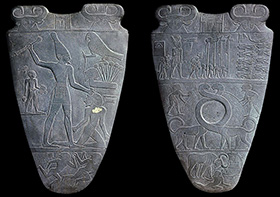Early Dynastic Rulers
- Neolithic Period: 4500-3000 BCE
- Early Dynastic: 3000-2650 BCE
- Old Kingdom: 2650-2150 BCE
- 1st Intermediate Period: 2150-2040 BCE
- Middle Kingdom: 2040-1640 BCE
- 2nd Intermediate Period: 1640-1550 BCE
- New Kingdom: 1550-1070 BCE
- 3rd Intermediate Period: 1070-712 BCE
- Saite and Late Periods: 712-332 BCE
- Greco-Roman Period: 332 BCE-642 CE
- Coptic Period: 395-642 CE
- Islamic Period and Modern Times: 642 CE-Today
- Neolithic Period: 4500-3000 BCE
- Early Dynastic: 3000-2650 BCE
- Old Kingdom: 2650-2150 BCE
- 1st Intermediate Period: 2150-2040 BCE
- Middle Kingdom: 2040-1640 BCE
- 2nd Intermediate Period: 1640-1550 BCE
- New Kingdom: 1550-1070 BCE
- 3rd Intermediate Period: 1070-712 BCE
- Saite and Late Periods: 712-332 BCE
- Greco-Roman Period: 332 BCE-642 CE
- Coptic Period: 395-642 CE
- Islamic Period and Modern Times: 642 CE-Today
Narmer
fl. ca. 3000 BCE
Narmer was the first king of Egypt who peacefully unified the country at the beginning of the First Dynastic Period (ca. 3000 – 2650 BCE). He has also been cited as the last king of the Neolithic Period (ca. 4500-3000 BCE) who unified the country through conquest.
Narmer's identity is the subject of ongoing debates, although the dominant opinion among Egyptologists identifies Narmer with the pharaoh Menes. Egyptologist Flinders Petrie (1853-1942 CE) claimed that Narmer and Menes were the same person: Narmer was his name and Menes was an honorific title.
A palette of carved siltstone used to grind cosmetics found by Egyptologists in 1897 supports the theory that Narmer was the unifier of Egypt. On one side of the palette, it shows him wearing a white war crown of Upper Egypt, bashing an enemy. On the other side, it shows him wearing a red wicker crown of Lower Egypt as he surveys the bodies of his enemies, which many interpret to be a testament to his military unification of both lands. Later historians left his name out of the King Lists but Egyptologists have found many items mentioning him.

Image: The Narmer Palette at the Egyptian Museum Cairo, Egypt.

